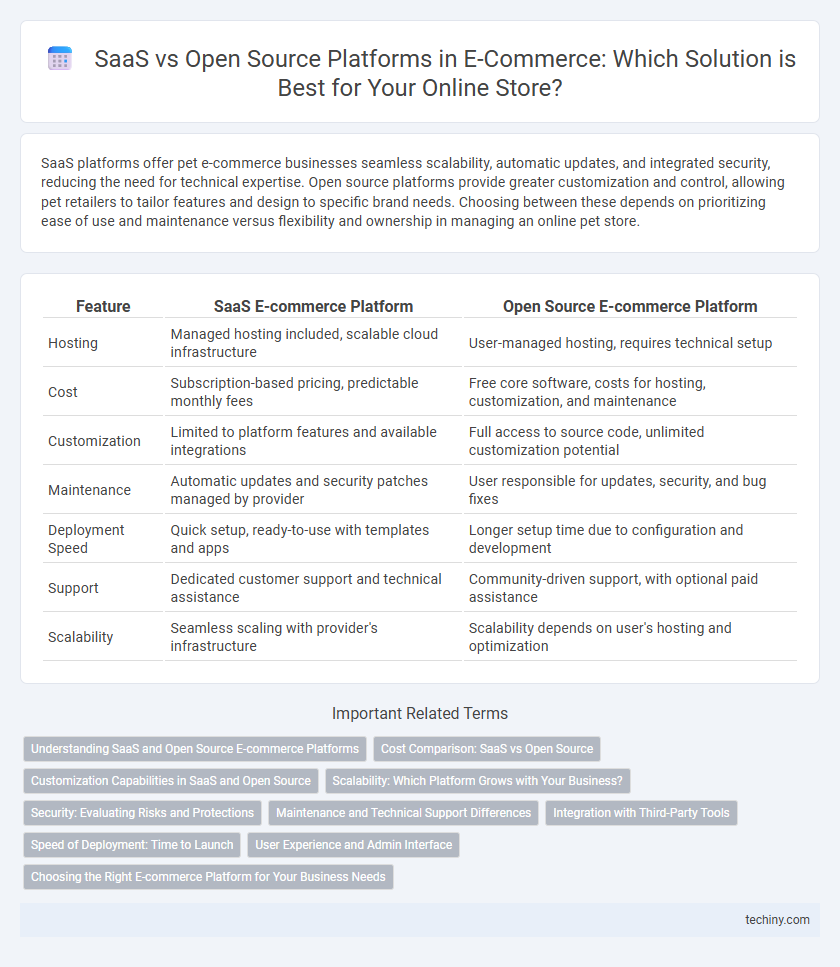SaaS platforms offer pet e-commerce businesses seamless scalability, automatic updates, and integrated security, reducing the need for technical expertise. Open source platforms provide greater customization and control, allowing pet retailers to tailor features and design to specific brand needs. Choosing between these depends on prioritizing ease of use and maintenance versus flexibility and ownership in managing an online pet store.
Table of Comparison
| Feature | SaaS E-commerce Platform | Open Source E-commerce Platform |
|---|---|---|
| Hosting | Managed hosting included, scalable cloud infrastructure | User-managed hosting, requires technical setup |
| Cost | Subscription-based pricing, predictable monthly fees | Free core software, costs for hosting, customization, and maintenance |
| Customization | Limited to platform features and available integrations | Full access to source code, unlimited customization potential |
| Maintenance | Automatic updates and security patches managed by provider | User responsible for updates, security, and bug fixes |
| Deployment Speed | Quick setup, ready-to-use with templates and apps | Longer setup time due to configuration and development |
| Support | Dedicated customer support and technical assistance | Community-driven support, with optional paid assistance |
| Scalability | Seamless scaling with provider's infrastructure | Scalability depends on user's hosting and optimization |
Understanding SaaS and Open Source E-commerce Platforms
SaaS e-commerce platforms offer hosted solutions with automatic updates, scalability, and integrated support, ideal for businesses seeking quick deployment and minimal technical management. Open source platforms provide full customization and control over the codebase, appealing to businesses requiring tailored features and ownership of their hosting environment. Choosing between these platforms depends on factors like budget, technical expertise, and the need for flexibility versus convenience in online store management.
Cost Comparison: SaaS vs Open Source
SaaS platforms typically involve predictable subscription fees covering hosting, maintenance, and support, reducing upfront costs but potentially increasing long-term expenses. Open source platforms offer zero licensing fees but incur variable costs from self-hosting, development, customization, and ongoing maintenance. Evaluating total cost of ownership (TCO) highlights SaaS ease of budgeting against open source flexibility and potential hidden costs in infrastructure and expertise.
Customization Capabilities in SaaS and Open Source
Open Source platforms offer extensive customization capabilities through access to full source code, enabling developers to tailor every aspect of the e-commerce site to specific business requirements. SaaS platforms provide limited customization options within a controlled environment, focusing on ease of use and faster deployment rather than deep code-level modifications. Businesses seeking highly flexible and unique storefronts often prefer Open Source solutions, while those prioritizing streamlined updates and lower maintenance may choose SaaS platforms despite customization constraints.
Scalability: Which Platform Grows with Your Business?
SaaS platforms offer seamless scalability by providing automatic resource allocation and cloud-based infrastructure that easily adapts to increasing traffic and sales volume. Open source platforms require manual optimization and infrastructure management, which may limit growth without significant technical expertise and investment. Selecting a SaaS platform ensures your e-commerce business scales efficiently with demand, while open source solutions provide flexibility at the cost of scalability complexity.
Security: Evaluating Risks and Protections
SaaS platforms offer built-in security measures managed by providers, reducing risks related to data breaches and compliance but limiting user control over security protocols. Open source platforms provide flexibility to customize security settings and implement tailored protections, though they require dedicated expertise to identify vulnerabilities and maintain updates. Decision-makers must weigh the trade-offs between managed security convenience and the necessity for in-house security management to mitigate risks effectively.
Maintenance and Technical Support Differences
SaaS e-commerce platforms offer continuous maintenance, automated updates, and dedicated technical support, ensuring minimal downtime and swift issue resolution. Open source platforms require manual maintenance, frequent security patching, and in-house or third-party technical support, often incurring higher operational costs and longer troubleshooting times. Choosing SaaS reduces the need for specialized IT staff, while open source offers more control but demands ongoing technical expertise.
Integration with Third-Party Tools
SaaS platforms offer seamless integration with a wide range of third-party tools through pre-built APIs and marketplace apps, enabling faster deployment and reduced maintenance efforts. Open source platforms provide greater flexibility for custom integrations but often require technical expertise and longer development times to connect with external services. Businesses prioritizing scalability and ease of use frequently prefer SaaS solutions, while those needing tailor-made workflows may opt for open source platforms to fully control third-party tool integration.
Speed of Deployment: Time to Launch
SaaS platforms offer faster time to launch with pre-built infrastructure, enabling businesses to deploy e-commerce stores within days or weeks. Open source platforms require extensive setup, customization, and hosting configuration, often extending deployment time to several months. Rapid deployment on SaaS platforms supports quicker revenue generation and market entry for online retailers.
User Experience and Admin Interface
SaaS e-commerce platforms deliver a streamlined user experience with intuitive, regularly updated interfaces optimized for both shoppers and administrators, minimizing downtime and technical maintenance. Open source platforms offer extensive customization of the user interface and admin dashboard, allowing businesses to tailor workflows and design but require more technical expertise and resources to achieve optimal usability. The choice impacts scalability, security, and speed of updates, with SaaS favoring ease of use and open source providing flexibility for complex, unique requirements.
Choosing the Right E-commerce Platform for Your Business Needs
Selecting the right e-commerce platform hinges on aligning features with business goals, where SaaS platforms offer hosted solutions with seamless updates and scalability, ideal for businesses seeking low maintenance and rapid deployment. In contrast, open source platforms provide extensive customization opportunities and control, suitable for enterprises with technical resources aiming to tailor functionality precisely. Evaluating factors like budget, technical expertise, scalability, and desired customization ensures the chosen platform supports growth and enhances customer experience effectively.
SaaS Platform vs Open Source Platform Infographic

 techiny.com
techiny.com